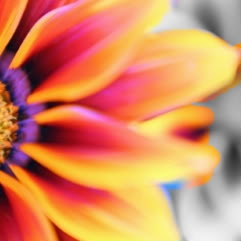Hi, this time its Raga Abheri, known as Bhimplasi in the Hindustani Sangeet. This is a very simple and yet a captive raga popularized through various genres like theatre and cinema, apart from classical music. It was one of the most favourite choices of opera writers/ composers even in the pre independence era. It is very soothing to hear and almost everyone knows a song in this raga..but just that they don’t know that it is Abheri!!
Let’s get into the details. Abheri, as it is known in South Indian Classical Music ,is an Oudava Sampoorna ( meaning it takes SGMPN – five notes in the ascent and SNDPMGR in the descent). It is the Janyam of Karaharapriya the 22nd mela, which in itself is a very pleasing raga. Just that, skipping the Rishabam and Nishadam in the ascent changes the colour and mood of the raga completely. It is more dramatized than its origin raga and hence more preferred for operas. Also the occasional usage of shuddha dhaivatham (which is a foreign note) , just at the right phrase gives an unexpected yet beautiful feel for the raga.
Some of the important phrases of this raga are GMPN,,D,,P- PG,,M PNS – NSR NS- PNSGRNS- GR, NP, GR, NP, S.. The raga has a range of about two octaves and the skipping of notes in consequent phrases is a speciality, especially SPGRNPS is a typical phrase of the raga. Likewise NSMPG is also an important phrase. Interestingly the Rishabam, which shares a Vadi- Samvadi relationship with the Dhaivatham, is more prominent than dhaivatham itself. This is evident from the many phrases which end on Ri and those which move around Ri. Dhaivatham on the other hand does not enjoy that importance though.
Some important compositions in this Raga are: Nagumomu of Sri Thyagaraja- immortalized by legends like Shri M Balamuralikrishna, Semmangudi Sri Srinivasa Iyer, MS Subbulakshmi and Madurai Mani Iyer and others. The sahithyam or the Lyrics of the kriti blends so beautifully with the flow of the raga, that its very hard for anyone to not sing along or experience that high . This krithi was a favourite for elite and non-musicians alike.
This is a rendition of this krithi by the Legend Sri M Balamuralikrishna.
Bhajare Manasa of Mysore Vasudevachar is also a very famous Krithi in this raga. This is a rendition on the Veena by Vidwan D Balakrishna.
Another famous krithi is Maname ganamum maravadhe of Papanasam Sivan. This song featured in the movie “Savithri”. The swara shuddha dhaivatham which is a rare occurrence in this raga is used in the very beginning of the song. This is believed to be the older version of raga Abheri. Muthuswami Dikshitar’s Veenabheri also follows the same version. Whereas in krithis like Nagumomu or bhajare, that swara doesn’t occur. This is thDhaivatham is Bhimplas and is also believed to be the older version of Abheri and the exact equivalent of the modern day version of Raga Abheri modified version of the raga. “Eppadi Padinaro” of Suddhananda Bharathi is also a often heard song in this raga. Bharathiyar’s “Vellai tamarai” is also set in this raga.
Now, let us see how this raga is presented in Hindustani Music. As mentioned earlier the raga Bhimpalasi is the equivalent of the modern day raga Abheri. It is a late afternoon raga. Here are some beautiful renditions of Rag Bhimpalasi. Personally my choice is an instrumental version of this raga. Pt Hariprasad Chaurasia’s rendition explains more in detail how calming and meditative this raga can be!
Interestingly, Rag Dhanasri is the Punjabi version of Abheri/Bhimpalasi. It is exactly the same as the ragas under study. Swati Tirunal Maharaja’s composition was immortalized by Smt MS SUbbulakshmi. (Ignore the titles of the video; they are wrong)
The following is in Raag Dhanasri accompanied by the Harmonium as accompaniment by Dr Gurnam Singh.
This is more like a khayal rendition in terms of pace , improvisation and the accompanying style of Tabla.
This raga sounds undoubtedly divine and soothing on the Sarangi. Interestingly the Dhaivatham is more often heard in the chord played on the Harmonium. This elevates the aesthetic appeal of the raga traditional kirtan of Gurmat Sangeet.
Now for some famous movie songs old and recent. Film music in the 50s seem to have been instrumental in bringing out the best of this raga by using it extensively. Almost every composer has composed in this raga. Some examples here…
Nainon me badar chaye from Mera Saaya, Music by Madan Mohan
The use of Komal Dhaivath in the very beginning of the song gives a beautiful shade to the emotion of the song.
The ever green Singara Velane Deva from the movie Konjum Salangai. This song was sung by S Janaki to the accompaniment of Nadaswaram by Karukkurichi P Arunachalam.
This is yet another famous song from the movie “Tiruvilaiyadal” sung by TR Mahalingam, music composed by KV Mahadevan. This song is perfect is example for the immense scope this raga gives for high drama.
Other songs include Neela vana sung by SPB from Vazhve mayam is a ghazal type song composed by Gangai Amaran. CHinnanjiru vayadil from Meendum Kokila, Music by Ilayaraja.
Kannodu Kaanbadellam from the movie “Jeans” & Kismat Se Tum from the movie “Pukar”, both composed by A R Rahman, are also in this raga.
The list goes on and on. In part two of this article we shall see about the raga Shudha Dhanyasi/ Dhani.
(Krithika is a performing vocalist from Chennai. She is a disciple of (Bombay) Smt Jayashri Ramnath. She holds an MPhil in Indian Music . Apart from concert performances, she records vocals for various dancers and teaches music. )




